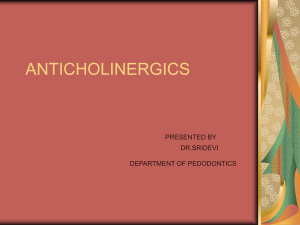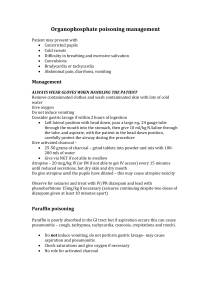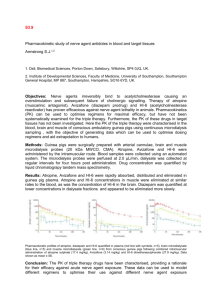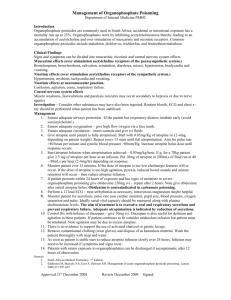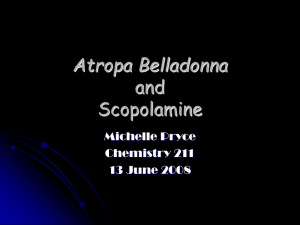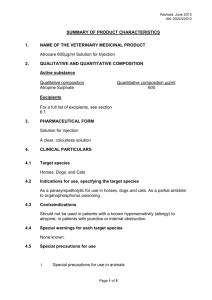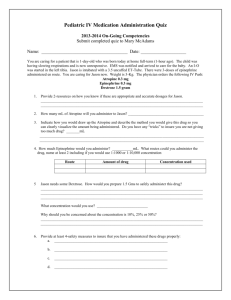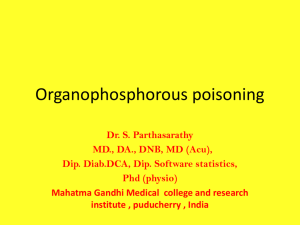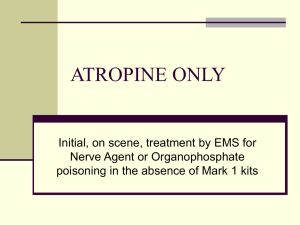Atropa belladonna:
advertisement
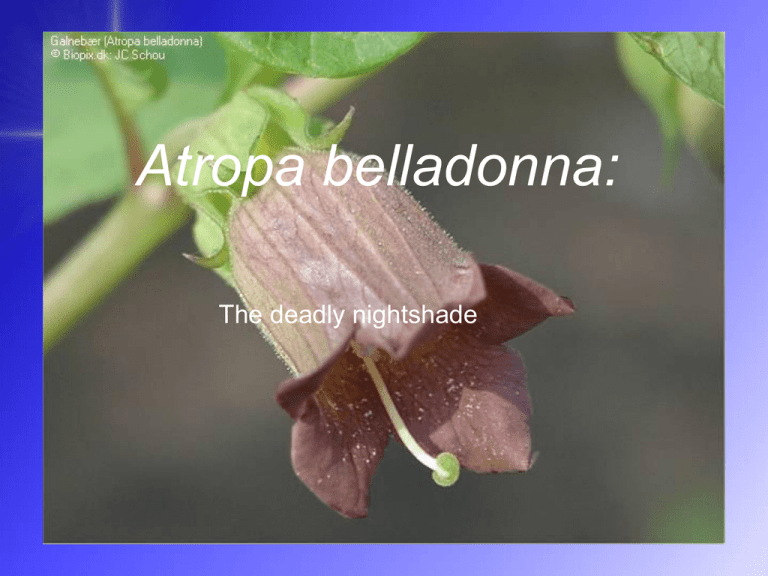
Atropa belladonna: The deadly nightshade Taxonomy Kingdom: Class: Order: Family: Genus: Species: Plantae Magnoliophyta Solanales Solanaceae Atropa A. belladonna • Atropa Taxonomy (cont.) – From the Greek God Atropos • One of the fates that cut the thread of life • Belladonna – “Beautiful Lady” in Italian • Common Names: – Deadly Nightshade – Devil’s Herb – Apples of Sodom • Same family as the potatoes, tomatoes, eggplants, tobacco, chili peppers, etc. Morphology & Botanical Relationships • Low growing perennial herb/shrub that grows 2-6 ft tall • Not hardy perennial • Sensitive to being transplanted • Thick root • Leaves – Simple, alternate Morphology & Botanical Relationships (cont.) • Flowers – Solitary bell-shaped (drooping and tubular) – 5-lobe – Dull red-purple or greenish purple • Fruit – Glossy, purple-black berries – Green berries turn purplishblack as plant matures Species Distribution • Native to Eurasia • Naturalized in many parts of the world • Cultivated/harvested in US: – California, Oregon, Washington, Michigan, New Jersey, New York • Some farms even export to Europe Habitat • Seeds are small: about 10,000 plants will germinate from 1-2oz of seed • Germination takes up to several weeks – In warm, moist, sterile soil • Plant requires: – rich, moist – plenty of fertilizer – weed free environment Habitat (cont.) • Landscape in flower gardens as herbaceous flowering ornamental • May even be considered a weed in some areas • Plant is usually high yielding – But susceptible to wilt disease caused by potato beetle and flea beetle Active Compounds Tropane Alkaloids Atropine C17H23NO3 C17H21NO4 Hyoscyamine C17H23NO3 Scopolamine History of Uses • Attributed to the Bacchanalian orgies – Women tear off clothes, go into frenzied dances and literally throw themselves at men • Used in witches’ brew and flying ointments – Anointed broomstick History of Uses (cont.) • Romans used plant as a “weapon” – Contaminated enemies food storage • Used to poison the troops of Marcus Antonius during the Parthian Wars. • Scottish troops used it during a truce to subdue the invading Danes. – Legend: Scottish troops put belladonna into enemies’ liquor supply – Waited for enemies to fall asleep and then kill them History of Uses (cont.) • “Truth serum” in the old days – Used in many legal battles and court cases • Cosmetics: – Spanish and Italian Women • Extracts used as eye drops to dilate pupils, giving pupils a more intense, hypnotic, and attractive appeal • Because pupil dilate when people are aroused; therefore, making eye contact more intense History of Uses (cont.) • Pain reducer: – 1992: Scopolamine added to morphine to cause “twilight sleep” • Lessened the pain and mortality of childbirth • Life saver: – In 1943 (WWII), the Germans had developed a nerve gas in which Atropa (atropine) was the only antidote – In Tijuana Mexico (1967), people poisoned by insecticide – parathion - when they ate the bread that was exposed to the chemical • Use of atropine saved many lives Uses in Medicine • Slows action of smooth muscle system – Parkinson’s symptoms – Irregularities in heart rate – Dilates pupils – Reduces salivation – Stomach and bladder cramps – Helps to relax pre-surgery patients Uses in Medicine Cont. • Combats infection and decreases pain when combined with methylene blue, phenyl salicylate, and benzoic acid. • Prevents nausea and vomiting caused by motion sickness • Counteracts the effects of nerve gas. Recent Studies • Study done in 2006 – Older patients who could not reach their target heart rate were given atropine. – Control group did not receive atropine when they did not reach their target heart rate. – Those who received atropine were able to reach their target heart rate while the control group was not. Recent Studies 2007 Singapore • One group of children received atropine eye drops in one eye while the other eye was allowed to progress naturally. • Second, control group was given saline eye drops. • The eye in which the experimental group received the atropine eye drops was found to stop myopic progression while the other eye progressed naturally. • The control group saw no such benefits from their saline eye drops. Effects on Humans • • • • • • • • Increased/rapid heart rate Fits of laughter Inability to urinate Dilated pupils Dryness of mouth Nausea, vomiting Muscle failure Exhaustion Signs of Overdose • • • • • • • • Stop perspiring Rise in body temperature Inability to see or blurred vision Hallucinations Flushed skin Confusion Coma Death Harvesting and Processing - Harvested at full bloom - Can be harvested as soon as the first year of growth (1crop obtained) - Continue harvesting for 2-4 years (2-3 crops) - Once plant is two years old, can harvest twice a year: June and September. - After fourth year, all of plant is cut down and new seeds are planted - Because there is no further increase in alkaloid content Harvesting and Processing Cont. - For the first few years all of the plant save for the last inch or so is cut away. - The harvested portions of the plant are allowed to dry in the sun. - Chemical extraction and isolation result in the production of atropine. - Atropine sulfate is stored in a 0.9% saline solution and preservative (benzol alcohol) Summary • What we planned to do initially - carrots • Atropa belladonna is a member of the Solanaceae (potato) family • Although it is a poisonous plant, it still has many uses. Ironically, among the important ones are medicinal use • Mainly used to speed up heart rates What We Think? • We found it to be an interesting plant • A prime example of a highly poisonous plant, yet still very useful for us • Atropa belladonna is a plant that has ongoing research done on it – mainly to study affects of the tropane alkaloids • Maybe they’ll “accidentally” find some other uses of the plant??? References • • • • • • • • • • • • • • • • Emboden, William. Narcotic Plants. Collier Books, New York, 1980. Fan, D. S. P.; Lam, D. S. C.; Chan, C. K. M.; Fan, A. H.; Cheung, E. Y. Y.; Rao, S. K. “Topical Atropine In Retarding Myopic Progression and Axial Length Growth in Children with Moderate to Severe Myopia: A Pilot Study”. Jpn J Ophthalmol 51, 27-33, 2007. Simpson, Beryll. Economic Botany: Plants in our World, 3rd Ed. McGraw Hill, New York, 2001. http://plants.usda.gov/java/profile?symbol=ATROP http://www.ams.usda.gov/NOSB/MaterialsReview/AtropineFinalSupplement.pdf http://www.biopix.dk/Photo.asp?PhotoId=1697 http://www.ces.ncsu.edu/depts/hort/consumer/poison/Atropbe.htm http://www.eyehealthillinois.org/dilatedbig.html http://www.herbs2000.com/herbs/herbs_belladonna.htm http://www.rz.uni-karlsruhe.de/~db26/fotos/_Gift-_und_Arzneipflanzen?C=D%3BO=A http://www.siu.edu/~ebl/leaflets/atropa.htm http://www.swsbm.com/Images/New10-2003/Atropa_belladonna-7.jpg http://www.triora.org/processo_ing.html http://www.uic.edu/sph/glakes/kids/case1/slides1/ss14.htm http://www.whatreallyhappened.com/WITCHES/witches.html Questions?? Thank You!
